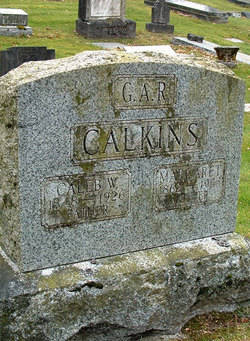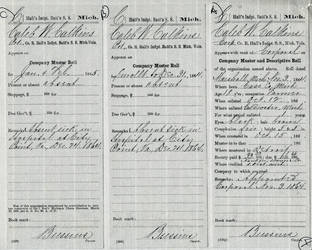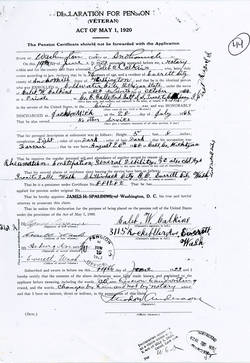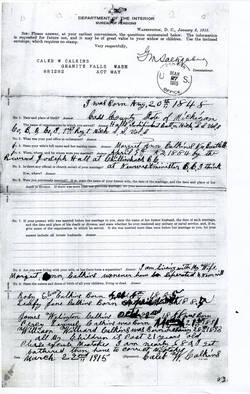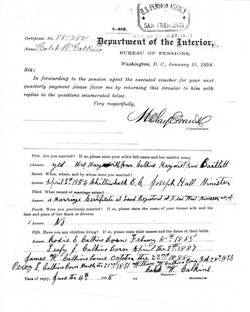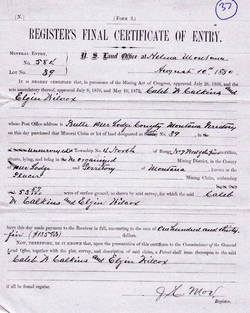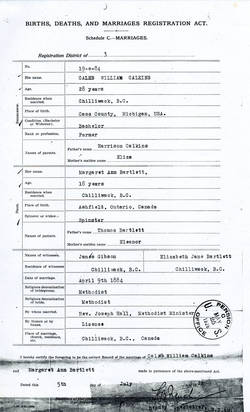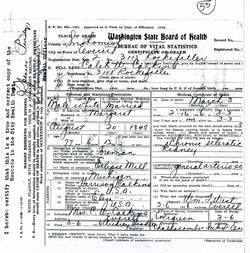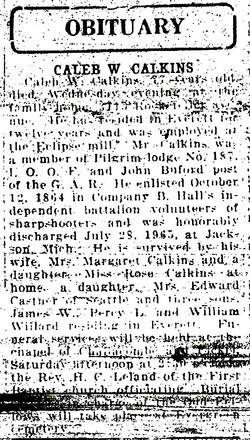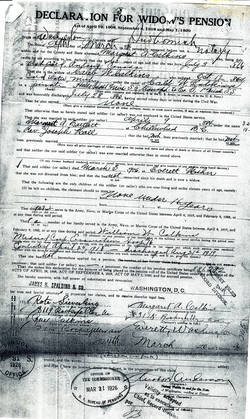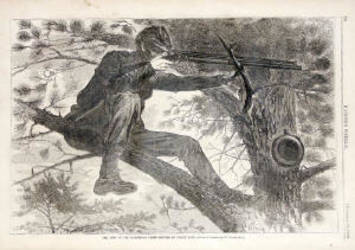Caleb W. Calkins
Representing: Union
G.A.R Post
- John Buford Post #89 Everett, Snohomish Co. WA
Unit History
- 16th Michigan Hall's Independent Battalion SharpShooter B
- 1st Michigan Sharpshooters I
Full Unit History
HALL'S INDEPENDENT BATTALION VOLUNTEER SHARPSHOOTERS
Organized: 8/27/64 to 11/2/64 Marshall, MI
Consolidated/Transferred: 3/15/65 to 1st MI SS
1st MICHIGAN VOLUNTEER SHARPSHOOTERS
Organized: 1862 Kalamazoo, MI - 1863 Dearborn, MI
Mustered In: 7/7/63
Mustered Out: 7/28/65 Delaney House, D.C.
Discharged: 8/7/65 Jackson, MI
Regimental History
REGIMENTAL HISTORY: (Hall's)
There is next to no information available pertaining to Hall's sharpshooter unit. According to Dyer's "A Compendium of the War of the Rebellion" Vol. 3, the unit was "attached to the 16th Michigan Infantry and consolidated with that Regiment on April 10, 1865." However, a review of that regiment's history reflects only two sharpshooter organizations having been attached to it and neither was Hall's.
Assignment data provided by Historical Data Systems, Inc. indicates Hall’s; a "three year" unit was, from January, 1865 to April, '65, with the engineer brigade of the Army of The Potomac. As such, Hall's was an "eastern theater" organization prior to and after its transfer to the 1st Michigan Sharpshooters in mid-March, 1865.
Officers killed or mortally wounded: 0 - Officers died of disease, accidents, etc.: 0- Enlisted men killed or mortally wounded: 1 - Enlistment men died of disease, accidents, etc: 5.
REGIMENTAL HISTORY: (1st)
The 1st was a three year, regimental-sized, eastern theater sharpshooter organization. Active service for a portion of the unit came in mid-1863 when they were ordered to Indiana to intercept Confederate forces under John Morgan. Severe skirmishes with the raids followed after which the 1st moved into Ohio where the Rebel band was captured. An assignment guarding Confederate prisoners of war near Chicago, IL followed.
In March, 1864, the regiment left Chicago and joined the forces of Union General U.S. Grant was they moved southward into Virginia for the Overland Campaign. During the months ahead the unit would suffer severely in many engagements including the Wilderness, Spotsylvania, the Po and North Anna rivers, Cold Harbor and the initial union assaults upon Petersburg. During the ensuring siege of that city the 1st was engaged at Weldon Railroad, Reams' Station, Pegram's farm and the Boydton Plank Road.
On April 2, 1865 the regiment made a desperate and daring charge upon the enemy's Petersburg fortifications and actually succeeded in breaching those works and holding them for a time. On the morning of April 3rd, the 1st again advanced upon the Rebels and, finding the enemy not in his entrenchments, gained the enviable notoriety of being the first Union regiment to march into the City of Petersburg. Accepting the surrender of the city from the mayor, the flag of the 1st was raised over the court house.
The War ended, the 1st proceeded to Alexandria, VA and subsequently participated in the Grand Review in Washington City. From there the regiment moved back to Michigan for final payment and disbandment.
Soldier History
SOLDIER: (Hall's)
Residence: Porter, Cass Co., MI Age: 16.1 yrs.
Enlisted/Enrolled: 10/12/64 Coldwater, MI Rank: Pvt.
Mustered In: 10/15/64 Detroit, MI
Transferred Out: 3/15/65
Highest Rank: Cprl.
SOLDIER: (1st)
Residence: Porter, Cass Co., MI Age: 16.6 yrs.
Transferred In: 3/15/65 Rank: Pvt.
Mustered Out: 7/28/65 Delaney House, Washington, D.C.
Highest Rank: Pvt.
Family History
PERSONAL/FAMILY HISTORY:
On October 17, 1847 farmer William Harrison Calkins (b. 1819 NY.) married Eliza (nee Shivel b. 1816 OH) O'Dell. Previously married to Nathan G. O'Dell, she brought two children into household: daughter Wealthy O’Dell (b. 1843 MI) and son Nathan G. (b.1845 MI). William and Eliza's first child, Caleb William, was born August 20, 1848 in Porter, Cass County, Michigan. A daughter, Mary D. was born, also in Michigan, in 1850. As best as can be determined, Caleb and Mary were the only Calkins children born from the union of William and Eliza.
Beyond his parentage, date and place of birth, the first documented information on Caleb comes from his 1864, one year enlistment in the U.S. Army as a teenaged farmer turned sharpshooter. A likely inducement for the enlistment was a $100 bounty or, as it would be called today, "enlistment bonus." His vital statistics at that time were 5'8" or 9" in height, with dark hair, dark eyes and a dark complexion.
Caleb's military experience started out on a positive note as on 11/3/64 he was appointed to the rank of corporal. About the same time, however, he began to experience physical problems that would prove to make his service tenure a medical nightmare. While encamped with his regiment near Marshall, Michigan at the fairgrounds he contracted an acute case of smallpox-like measles called "black measles." Additionally, he caught a cold. Medically treated in fairground sheds, he was not expected to live, but live he did, albeit with resulting "weak lungs."
By December 23/24 of 1864 Calkins was again hospitalized, this time near City Point, Virginia near the Union front lines around the besieged city of Petersburg. According to Calkins' telling he and his comrades camped near City Point had fixed up log huts and covered them with pieces of tents buttoned together (for roofing). These were supposed to be their "winter quarters." According to his telling, "We expected to be there for the winter, but we were disappointed...I remember the sound of the bugle when it called us out of our bunks (into) the rain.....we marched quickstep to the front near Richmond where we lay in the muddy trenches. It rained nearly all the time day and night.....after a time we were marched back..... (During the) last part of December I was taken with typhoid (fever)... and (nearly) out of my mind." While hospitalized near city Point with typhoid he was also stricken with piles (hemorrhoids), the “one two" punch of the conditions occurring so closely together would trouble him for the remainder of his life.
While above described medical problems seem almost overwhelming, Corporal Calkins' ills were not yet over as by 2/1/65 he was stricken with rheumatism. He later recalled "for the first time in my life. (My) knee joints and legs (were) swollen.... (but I) did duty all the time.... (I was) also troubled with diarrhea (which) did not affect me so much until about March, 1865......Near the same time.....I had sour stomach, (so) food passed through me undigested....(I was) continually thirsty so drank more (unhealthy) water....some of the boys died of diarrhea."
On 2/6/65 while hospitalized near City Point Corporal Calkins was visited by a representative of the U.S. Christian Commission's Individual Relief Department. That individual's notes read as follows: "Cause of Disability= fever, probably typhoid. Religious Condition = Said he had made up his mind to be a better boy. Seems to be agitated by fears. “Just coming down with fever."
On 2/13/65 Corporal Calkins was returned to duty and to the Petersburg front. Not long after, his unit was consolidated with the 1st Michigan Sharpshooters, a move which cost him his corporal's stripes. He would remain a private throughout the remainder of the War.
On 4/2/65 Private Calkins was a participant in the brief Union breakthrough at Ft. Stedman outside Petersburg. The following day Union troops entered that long-besieged city. He later recalled: "Huzzah, it thrills my heart yet....planting our flag first on the courthouse of Petersburg.
The end of the War and final discharge came not long afterwards. Even so, his trials were not over as related in the following: "While at Marshall (I think) Michigan while pushing my way through a crowd of people to get my (train home) ticket form the ticket master my pocket was picked. I lost my pocket book...quite a bit of money and my discharge paper." In later years he would request and receive a replacement of this discharge certificate.
Calkins' continues his story: “When I got out of the service and went home (I) was (physically) but a shadow of my (former) self. (I) drank lots of sweet milk, kept quiet and ate light food. I was under medical care for six months."
The census for 1870 found Caleb residing in his old childhood home area of Porter, Cass County, Michigan. At the time he was employed as a farmhand. By 1877, however, he had moved westward to Montana Territory where, near Butte City he was working "in wet mines." This did nothing to help his old rheumatism problems......
By 1879 Caleb, along with three others - Chancy Fosdick, Elgin Wilcox and Cary B. Wilcox - had established claim to a placer mine along a creek in an area known as Summit Valley. In early 1880 Fosdick and Cary Wilcox transferred ownership of the claim to Caleb and Elgin Wilcox. However, Caleb's involvement in the stream-based mining operation was apparently short lived as the census of Butte, Deer Lodge Co., MT Terr. for that same year found him employed as a "wood chopper" and living in a boarding house. Even so, on 8/10/80, with all fees having been paid, final claim ownership was granted...............
1882. Circa this year Caleb began a relationship with one Margaret Ann Bartlett (b.7/3/65 or '67 Ashfield, Ontario, Canada). Exactly where the two met is not documented, but they were married on 4/3/84 in Chilliwack, British Columbia, Canada. The couple' first child Rose "Rosie/Rosey" Elenor was born on 2/4 or 2/8 of the following year. The union would ultimately produce a total of five children the additional four being: Leafy Jane (b. 4/8/87 B.C., Canada), James Welington/Wellington (b. 10/2 or 22/88 B.C. Canada), Percy Lemuel (b. 3/21/91 Nevada U.S.A.) and William Willard (b. 6/28/93 Nevada U.S.A).
It appears the Calkins family moved from Canada to the United States sometime in 1889 settling in the State of Nevada. There, in March, 1891, Caleb received an injury to his left eye from a flying piece of steel while working in a mine. Exactly where that mine was located is not documented, but as of 5/16/93 the Calkins family was living in Candelaria, Mineral County, Nevada. That date and location is affirmed by Caleb's receipt of a $6 per month U.S. Government disability pension based on his being partially unable to perform manual labor because of chronic rheumatism and diarrhea which he traced back to exposure to the elements and drinking bad water while in the U.S. Army.
The census for 1900 found the Calkins in or near the community of Douglass in Esmeralda Co., Nevada. Caleb's occupation was listed as "gold miner." A year later, December, 1901, the family was still in Nevada, but then living in the Esmeralda community of Sodaville. However, by May 26 of 1903 they had relocated to Rosedale Chilliwack County, British Columbia, Canada. Exactly how long they remained there is not known, but by October 1st, 1906 they were back in the U.S. residing in Granite Falls, Snohomish County, Washington. In May of that same year, either in Canada or in the U.S. Caleb received a severe saw cut to his upper right arm.
The census for 1910 still placed the Calkins family in Granite Falls with Caleb mining for gold. That same year saw his disability pension increased from six to $12 per month.
A decade later: 1920. By this date the family was residing in the Snohomish County City of Everett where they had moved from Granite Falls around 1914. In Everett Caleb was noted as being a laborer in a lumber mill.
By January of 1922 Caleb's health had declined to a point where he reportedly was confined to bed or to his house at times and needed assistance of another in his daily life. Because of his condition an increase to $72 was being sought. The request was rejected on the grounds that he did not need REGULAR aid and assistance from another.
As of February, 1926 Caleb's pension had been increased It was not to the princely sum of $72 per month as earlier requested, but it was up to at least $50. That was the amount he was receiving when he died shortly thereafter on March 24th at his home located at 3115 Rockefeller in Everett. Cause of death was listed as a chronic sclerotic, Paget’s disease (a bone disorder) and kidney problems with general arteriosclerosis contributing. At his passing the old soldier, whose last occupation was tagged as "foreman" at the "Eclipse Mill," was 77.7 years of age. Burial was in Everett's Evergreen Cemetery.
Almost immediately following Caleb's death Margaret began collecting $30 per month of her late husband's disability pension. The stipend was ultimately upped to $40 and, although an attempt was made increase it further, the Government responded that $40 was the maximum amount for a widow pension.
Margaret remained at the 3115 Rockefeller address in Everett for the remainder of her life. Living with her at least a portion of her years were son William and and/or daughter Rose. Margaret died at home on January 2nd, 1953. She was buried beside Caleb at Evergreen Cemetery.
Cemetery
Buried at Evergreen Cemetery Everett
Row: 35
Site: 535
